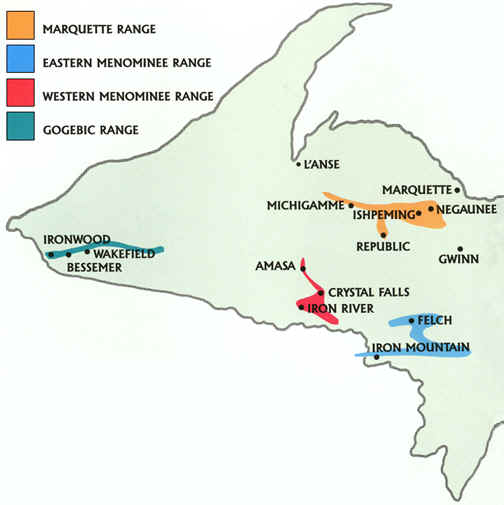MENOMINEE IRON RANGE
�No single resource, unless it be coal or soil, is so vital to the economic growth of the modern nation as iron. Iron ore deposits situated like those of the Lake Superior district, of such high grade, in such a limited area, and so easily mined on a large scale, could not fail to affect the whole nation. Their production, utilization, and conservation concern the whole people.� �George J. Miller (p. 882)
The Menominee Iron Range is located in the Western Upper Peninsula of Michigan and is one of the greatest iron districts in the region. Named for the Menominee River which runs through it, the range included eight mines; the Vulcan, Chapin, Cyclops, Breen, Quinnesec, Norway, Garfield and Caspian.

In 1846 William A. Burt, the discoverer of the Marquette Iron Range, during his linear land survey, noted signs of iron ore in the Crystal Falls area. In 1849, federal geologist J.W. Foster was sent by Dr. Charles T. Jackson to investigate the reports of iron ore on the Menominee River. His reports listed significant finds of large beds of ore in Section 30, Township 40 North, Range 30 West, near Lake Antoine. Almost two years later, Foster was joined by J.D. Whitney and through a geological survey they together confirmed Burt�s report of the Crystal Falls district.
In 1866, two timber speculators from Menominee named Thomas and Bartley Breen located iron deposits near what is now Waucedah, Michigan. In 1972, this site became know as the Breen Mine and marked the first mining in the district. Soon after, Milwaukee Iron Company geologist and chemist Dr. Nelson P. Hulst began conducting extensive prospecting on the Breen property and a property that would later be known as the Vulcan Mine.
But in the fall of 1873, the development of the mine was slowed when the effect of the national economic panic hit the Menominee Range and all preparation for mining ceased. By 1874, due to the prior prospecting of Hulst, it became evident that mining was a valuable venture and plans were back on track. However, they would be again delayed until 1877, when the Chicago and Northwestern Railway Company completed a railroad stretching from Quinnesec to Escanaba, easing shipping problems. During this year, the Breen and Vulcan mines shipped 10,405 tons of ore.
By 1878, five mines were actively shipping from the Menominee Range, including the Breen, Cyclops, Norway, Quinnesec, and the Vulcan. By 1879, there were eight shippers moving over 200,000 tons of iron ore. Production at the Menominee Range continued to increase in the following years, and by 1882 it passed the one million mark in shipment. Total more than one and a half million tons were mined in the first five years and in the sixth year its production exceeded a million tons, �an amount which it had taken the Marquette Range more than twenty years to equal� (Miller 884).

The range hit its peak in 1920 when it shipped nearly seven million tons of iron ore. However in the 1930s, high grade ore, once plentiful, became less available and less profitable, as the cost of underground mining became more prohibitive and many of the smaller mining companies were absorbed by large corporations.
Today, ruins are all that exist of the once booming Menominee mines.
Menominee Ores
Menominee ores of value generally occurred in the upper Huronian rocks in the southern most part of the district. The ores were mainly gray, finely-banded hematites and were complexly folded. The high-grade ores of this range are estimated at about 80 million tons, and the non-available ore at 7.3 billion tons.
The importance of Menominee Iron in the US (Historically and today)
The production of iron has been a crucial thing in the US and according to George Miller�s article �Some Geographic Influences of the Lake Superior Iron Ores,� Lake ores were �fundamental in making America the world�s greatest iron and steel producer� (914).
In 1870, the United Kingdom led the pack, producing half of the world�s pig iron, while the United States fell in a poor second producing only 13.8 percent. However, once the 1880s hit and lake ores were discovered, the US became firmly established in the industry. By 1890 the US surpassed all of its rivals, producing 1/3 of the world�s pig iron and steel. As of 1910, the US produced 42 percent of the world�s pig iron and 42 percent of its steel (Miller 914).
Without the ore of ranges like those found in Menominee, this would never have been accomplished.
REFERENCES
Books-
Ingalls, E.S. The Iron Mines of Menominee County, Michigan. Mid-Peninsula Library Federation, 1972
Ingalls, E.S. Centennial history of Menominee County. Mid-Peninsula Library Federation, c1973.
Articles-
Miller, George. 1914. �Some Geographic Influences of the Lake Superior Iron Ores.� Bulletin of the American Geographical Society, Vol. 46, No. 12. 881-916.
Page created by Lyndsay Davis, a GEO 333 student
This material has been compiled for educational use only, and may not be reproduced without permission. One copy may be printed for personal use. Please contact Randall Schaetzl (soils@msu.edu) for more information or permissions.